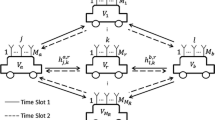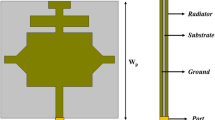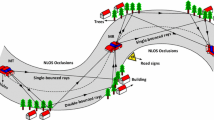Abstract
A holistic performance analysis and classification of multiport antennas (MPAs) is conducted in this paper. We focus on 5.9 GHz vehicle-to-vehicle communications suited to the emerging technology of intelligent transportation systems. Three-dimensional (3-D) uniform/isotropic, directional, and omnidirectional propagation scenarios are considered to account for any wireless environment. The presented analysis can be adapted to any MPA with an arbitrary number of ports, operating in any frequency band, or used in other emerging technologies such as in 5G and beyond 5G communications. On top of the classical key performance metrics (KPMs) in communication theory, i.e., the diversity antenna gain (DAG) and channel capacity (CC), we employ for the first time the energy efficiency as one more KPM capable to characterize performance and classify MPAs, particularly when DAG and CC fail to do so. Computation of the aforementioned KPMs departs from a covariance matrix formulation incorporating all intrinsic features that affect MPA performance, namely, MPA radiation characteristics, MPA termination conditions, and wireless propagation channel attributes. Accordingly, we derive the ideal form of the covariance matrix under the standardized and widely adopted 3-D uniform/isotropic wireless propagation scenario. A good MPA design should be one with a covariance matrix as close as possible to this ideal one. The adopted performance analysis methodology can thus inform the design of optimum MPAs and accordingly, we designed a proof-of-concept box-shaped MPA which shows outstanding performance across all propagation scenarios. It would be wise to conduct similar performance analyses as in this paper before releasing an MPA design.















Similar content being viewed by others
Data Availability
Data sharing not applicable to this article as no datasets were generated or analyzed during the current study.
Code Availability
Code availability not applicable to this article as no codes were generated or analyzed during the current study.
Change history
06 April 2024
The original article has been correted.
04 April 2024
A Correction to this paper has been published: https://doi.org/10.1007/s11277-024-10975-x
References
WWRF. (2017). Wireless communication using higher frequency bands, White Paper 5, no. 23, 2017. Available at https://www.wwrf.ch/files/content%20wwrf/publications/outlook/Outlook23.pdf.
Fallgren, M., et al. (2018). Fifth-generation technologies for the connected car: Capable systems for vehicle-to-anything communications. IEEE Vehicular Technology Magazine, 13(3), 28–38.
Yaqoob, B. I., et al. (2017). Internet of Things architecture: recent advances, taxonomy, requirements, and open challenges. IEEE Wireless Communications, 24(3), 10–16.
Durgin, G. D. (2003). Space-time wireless channels. Prentice Hall.
Yong, S. K., & Thompson, J. S. (2005). Three-dimensional spatial fading correlation models for compact MIMO receivers. IEEE Transactions on Wireless Communications, 4(6), 2856–2869.
Papamichael, V. C., & Karadimas, P. (2011). Performance evaluation of actual multielement antenna systems under transmit antenna selection/maximal ratio combining. IEEE Antennas Wireless Propagation Letters, 10, 690–692.
Karadimas, P., & Zhang, J. (2011). A generalized analysis of three-dimensional anisotropic scattering in mobile wireless channels-Part I: Theory. In 2011 IEEE Vehicular Technology Conference (VTC Spring), pp. 1–5.
Sangodoyin, S., et al. (2018). Cluster characterization of 3-D MIMO propagation channel in an urban macrocellular environment. IEEE Transactions on Wireless Communications, 17(8), 5076–5091.
Zhang, L., Luo, Z., & Leung, S.-H. (2017). An efficient approximation of spatial correlation based on gauss-hermite quadrature. IEEE Transactions on Signal Processing, 66(3), 617–626.
Forenza, A., Love, D. J., & Heath, R. W. (2007). Simplified spatial correlation models for clustered MIMO channels with different array configurations. IEEE Transactions on Vehicular Technology, 56(4), 1924–1934.
Huang, Y., Karadimas, P., & Pour Sohrab, A. (2023). Spatial channel degrees of freedom for optimum antenna arrays. IEEE Transactions on Wireless Communications, 22(8), 5129–5144.
Yao, Y., Shao, Y., Zhang, J., & Zhang, J. (2023). A transparent antenna using metal mesh for UWB MIMO applications. IEEE Transactions on Antennas and Propagation, 71(5), 3836–3844.
Kaiwartya, O., et al. (2016). Internet of vehicles: Motivation, layered architecture, network model, challenges, and future aspects. IEEE Access, 4, 5356–5373.
Sharawi, M. S. (2013). Printed multi-band MIMO antenna systems and their performance metrics. IEEE Antennas and Propagation Magazine, 55(5), 218–232.
Kildal, P. S., Rosengren, K., Byun, J., & Lee, J. (2002). Definition of effective diversity gain and how to measure it in a reverberation chamber. Microwave and Optical Technology Letters, 34(1), 56–59.
Loyka, S., & Kouki, A. (2002). New compound upper bound on MIMO channel capacity. IEEE Communications Letters, 6(3), 96–98.
Quist, B. T., & Jensen, M. A. (2009). Optimal antenna radiation characteristics for diversity and MIMO systems. IEEE Transactions on Antennas and Propagation, 57(11), 3474–3481.
Björnson, E., & Larsson, E. G. (2018) How energy-efficient can a wireless communication system become?. In 2018 IEEE 52nd Asilomar conference on signals, systems, and computers, pp. 1252–1256.
Jiang, J., Dianati, M., Imran, M. A., Tafazolli, R., & Chen, Y. (2013). On the relation between energy efficiency and spectral efficiency of multiple-antenna systems. IEEE Transactions on Vehicular Technology, 62(7), 3463–3469.
Deng, L., Rui, Y., Cheng, P., Zhang, J., Zhang, Q. T., & Li, M. (2013). A unified energy efficiency and spectral efficiency tradeoff metric in wireless networks. IEEE Communications Letters, 17(1), 55–58.
Tsilimantos, D., Gorce, J. M., Jaffrès-Runser, K., & Vincent-Poor, H. (2016). Spectral and energy efficiency trade-offs in cellular networks. IEEE Transactions on Wireless Communications, 15(1), 54–66.
Zhang, R., Li, Y., Wang, C. X., Ruan, Y., Fu, Y., & Zhang, H. (2018). Energy-spectral efficiency trade-off in underlaying mobile D2D communications: An economic efficiency perspective. IEEE Transactions on Wireless Communications, 17(7), 4288–4301.
Tang, J., So, D. K. C., Alsusa, E., Hamdi, K. A., & Shojaeifard, A. (2016). On the energy efficiency-spectral efficiency tradeoff in MIMO-OFDMA broadcast channels. IEEE Transactions on Vehicular Technology, 65(7), 5185–5199.
Papamichael, V., & Karadimas, P. (2017). On the covariance matrix and diversity performance evaluation of compact multiport antenna systems. IEEE Transactions on Antennas and Propagation, 65(11), 6140–6144.
Schwartz, M., Bennett, W. R., & Stein, S. (1995). Communication systems and techniques. London: Wiley.
Takada, J.-I., & Ogawa, K. (2003). Concept of diversity antenna gain. Paris, France, EURO-COST, vol. 273.
Papamichael, V., & Soras, C. (2010). Generalised selection combining diversity performance of multi-element antenna systems via a stochastic electromagnetic-circuit methodology. IET Microwaves, Antennas & Propagation, 4(7), 837–846.
Addepalli, T., & Anitha, V. R. (2022). Parametric analysis of compact UWB-MIMO antenna with improved isolation using parasitic reflectors and protruded ground strips. Wireless Personal Communications, 123, 2209–2225.
Chandel, R., Gautam, A. K., & Rambabu, K. (2018). Tapered fed compact UWB MIMO-diversity antenna with dual band-notched characteristics. IEEE Transactions on Antennas and Propagation, 66(4), 1677–1684.
Das, G., Sharma, A., & Gangwar, R. K. (2017). Wideband self-complementary hybrid ring dielectric resonator antenna for MIMO applications. IET Microwaves, Antennas & Propagation, 12(1), 108–114.
Alsath, M. G. N., & Kanagasabai, M. (2015). Compact UWB monopole antenna for automotive communications. IEEE Transactions on Antennas and Propagation, 63(9), 4204–4208.
Li, W., Hei, Y., Grubb, P. M., Shi, X., & Chen, R. T. (2018). Compact inkjet-printed flexible MIMO antenna for UWB applications. IEEE Access, 6, 50290–50298.
Gautam, K., Yadav, S., & Rambabu, K. (2018). Design of ultra-compact UWB antenna with band-notched characteristics for MIMO applications. IET Microwaves, Antennas & Propagation, 12(12), 1895–1900.
Ibrahim, A. A., Abdalla, M. A., & Hu, Z. (2018). Compact ACS-fed CRLH MIMO antenna for wireless applications. IET Microwaves, Antennas & Propagation, 12(6), 1021–1025.
Zhang, S., & Pedersen, G. F. (2016). Mutual coupling reduction for UWB MIMO antennas with a wideband neutralization line. IEEE Antennas Wireless Propagation Letters, 15, 166–169.
Jehangir, S. S., & Sharawi, M. S. (2017). A miniaturized UWB biplanar Yagi-based MIMO antenna system. IEEE Antennas Wireless Propagation Letters, 16, 2320–2323.
Kshetrimayum, R. S., Mishra, M., Aïssa, S., Koul, S. K., & Sharawi, M. S. (2023). Diversity order and measure of MIMO antennas in single-user, multiuser, and massive MIMO wireless communications. IEEE Antennas Wireless Propagation Letters, 22(1), 19–23.
Zhu, J., Li, S., Feng, B., Deng, L., & Yin, S. (2015). Compact dual-polarized UWB quasi-self-complementary MIMO/diversity antenna with band-rejection capability. IEEE Antennas Wireless Propagation Letters, 15, 905–908.
Patre, S. R., & Singh, S. P. (2018). Shared radiator MIMO antenna for broadband applications. IET Microwaves, Antennas & Propagation, 12(7), 1153–1159.
Nie, L. Y., Lin, X. Q., Xiang, S., Wang, B., Xiao, L., & Ye, J. Y. (2020). High-isolation two-port UWB antenna based on shared structure. IEEE Transactions on Antennas and Propagation, 68(12), 8186–8191.
Gómez-Villanueva, R., & Jardón-Aguilar, H. (2019). Compact UWB uniplanar four-port MIMO antenna array with rejecting band. IEEE Antennas Wireless Propagation Letters, 18(12), 2543–2547.
Jehangir, S. S., & Sharawi, M. S. (2020). A compact single-layer four-port orthogonally polarized Yagi-Like MIMO antenna system. IEEE Transactions on Antennas and Propagation, 68(8), 6372–6377.
Kim, Y. S., & Cho, D.-H. (2020). Design of four-port integrated monopole antenna using refraction effect of dielectric medium for pattern gain enhancement. IEEE Antennas Wireless Propagation Letters, 19(4), 621–625.
Anitha, R., Vinesh, P., Prakash, K., Mohanan, P., & Vasudevan, K. (2016). A compact quad element slotted ground wideband antenna for MIMO applications. IEEE Transactions on Antennas and Propagation, 64(10), 4550–4553.
Ramachandran, A., Mathew, S., Rajan, V., & Kesavath, V. (2016). A compact triband quad-element MIMO antenna using SRR ring for high isolation. IEEE Antennas Wireless Propagation Letters, 16, 1409–1412.
Fritz-Andrade, E., Perez-Miguel, A., Gomez-Villanueva, R., & Jardon-Aguilar, H. (2019). Characteristic mode analysis applied to reduce the mutual coupling of a four-element patch MIMO antenna using a defected ground structure. IET Microwave, Antennas & Propagation, 14(2), 215–226.
Saad, A. A. R., & Mohamed, H. A. (2019). Conceptual design of a compact four-element UWB MIMO slot antenna array. IET Microwave, Antennas & Propagation, 13(2), 208–215.
Mathur, R., & Dwari, S. (2019). 8-port multibeam planar UWB-MIMO antenna with pattern and polarisation diversity. IET Microwave, Antennas & Propagation, 13(13), 2297–2302.
Alsath, M. G. N., et al. (2018). An integrated tri-band/UWB polarization diversity antenna for vehicular networks. IEEE Transactions on Vehicular Technology, 67(7), 5613–5620.
Das, G., Sahu, N. K., Sharma, A., Gangwar, R. K., & Sharawi, M. S. (2019). Dielectric resonator-based four-element eight-port MIMO antenna with multi-directional pattern diversity. IET Microwave, Antennas & Propagation, 13(1), 16–22.
Koziel, S., & Pietrenko-Dabrowska, A. (2022). Rapid variable-resolution parameter tuning of antenna structures using frequency-based regularization and sparse sensitivity updates. IEEE Transactions on Antennas and Propagation, 70(12), 12177–12188.
Sohrab, A. P., Karadimas, P., Huang, Y. (2019). Covariance matrix evaluation of a diversity slot antenna for vehicular communications. In 2019 IEEE international symposium on antennas and propagation and USNC-URSI radio science meeting, Atlanta, GA, USA, pp. 931–932.
Taga, T. (1990). Analysis for mean effective gain of mobile antennas in land mobile radio environments. IEEE Transactions on Vehicular Technology, 39(2), 117–131.
Kalliola, K., Sulonen, K., Laitinen, H., Kivekäs, O., Krogerus, J., & Vainikainen, P. (2002). Angular power distribution and mean effective gain of mobile antenna in different propagation environments. IEEE Transactions on Vehicular Technology, 51(5), 823–838.
Fleury, B. H. (2000). First- and second-order characterization of direction dispersion and space selectivity in the radio channel. IEEE Transactions on Information Theory, 46(6), 2027–2044.
Alem, Y. F., Khalid, Z., & Kennedy, R. A. (2015). 3D spatial fading correlation for uniform angle of arrival distribution. IEEE Communications Letters, 19(6), 1073–1076.
Ando, A., Taga, T., Kondo, A., Kagoshima, K., & Kubota, S. (2008). Mean effective gain of mobile antennas in line-of-sight street microcells with low base station antennas. IEEE Transactions on Antennas and Propagation, 56(11), 3552–3565.
Papamichael, V. C. (2010). Selection-combining diversity performance of actual multielement antenna systems using the covariance matrix method. IEEE Antennas Wireless Propagation Letters, 9, 705–707.
Orfanidis, S. J. (2002). Electromagnetic waves and antennas. Available at http://www.ece.rutgers.edu/~orfanidi/ewa.
Goldsmith, A. (2005). Wireless communications. Cambridge: Cambridge University Press.
Goldsmith, A., Jafar, S. A., Jindal, N., & Vishwanath, S. (2003). Capacity limits of MIMO channels. IEEE Journal on Selected Areas in Communications, 21(5), 684–702.
Dumont, J., Hachem, W., Lasaulce, S., Loubaton, P., & Najim, J. (2010). On the capacity achieving covariance matrix for Rician MIMO channels: An asymptotic approach. IEEE Transactions on Information Theory, 56(3), 1048–1069.
Karadimas, P., & Matolak, D. (2014). Generic stochastic modeling of vehicle-to-vehicle wireless channels. Vehicular Communications, 1(4), 153–167.
Committee, E. C. (2013). The European table of frequency allocations and applications in the frequency range 8.3 kHz to 3000 GHz (ECA table). In Proceedings of European conference of postal and telecommunications administrations; electronic communications committee: Copenhagen, Denmark: Copenhagen, Denmark.
Kannappan, L., et al. (2023). Quad-port multiservice integrated optically transparent automotive antenna for vehicular classification applications. Scientific Reports.
Tadesse, A. D., Acharya, O. P., Sahu, S. (2021) A wideband four-port multiple-input-multiple-output slot antenna for WLAN/WiFi/5G below 6 GHz applications. International Journal of RF and Microwave Computer‐Aided Engineering, 31(5).
Che, J.-K., Chen, C.-C., & Locke, J. F. (2021). A compact four-channel MIMO 5G Sub-6 GHz/LTE/WLAN/V2X antenna design for modern vehicles. IEEE Transactions on Antennas and Propagation, 69(11), 7290–7297.
Funding
This work was supported by the Engineering and Physical Sciences Research Council (EPSRC) under grant EP/R027641/1: Bandwidth and Energy Efficient Compact Multi-Antenna Systems for Connected Autonomous Vehicles.
Author information
Authors and Affiliations
Contributions
All authors contributed to the study conception and design. All authors commented on previous versions of the manuscript. All authors read and approved the final manuscript.
Corresponding author
Ethics declarations
Competing interests
The authors have no relevant financial or non-financial interests to disclose.
Additional information
Publisher's Note
Springer Nature remains neutral with regard to jurisdictional claims in published maps and institutional affiliations.
The original version of this article was revised: In the sentence beginning 'We adopt the diversity antenna' in this article, the reference numbers '[6, 15]' should have read '[5, 6, 15]'. In the sentence beginning 'The arrangement that is used in this paper' a reference number was missing: '[, Fig. 7b]' should have read '[31, Fig. 7b]'. In Eq. (12), second line, WH before the equal sign should have been placed at the first line just after the bracket. The original article has been corrected.
Rights and permissions
Springer Nature or its licensor (e.g. a society or other partner) holds exclusive rights to this article under a publishing agreement with the author(s) or other rightsholder(s); author self-archiving of the accepted manuscript version of this article is solely governed by the terms of such publishing agreement and applicable law.
About this article
Cite this article
Pour Sohrab, A., Huang, Y. & Karadimas, P. Performance Analysis of Multiport Antennas in Vehicle-to-Vehicle Communication Channels. Wireless Pers Commun 134, 1231–1257 (2024). https://doi.org/10.1007/s11277-024-10875-0
Accepted:
Published:
Issue Date:
DOI: https://doi.org/10.1007/s11277-024-10875-0




